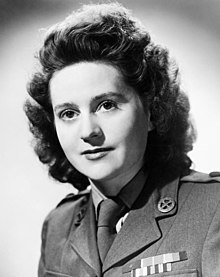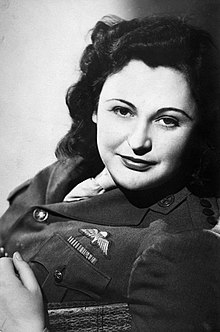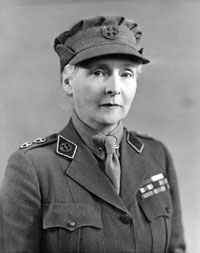First Aid Nursing Yeomanry
| First Aid Nursing Yeomanry (Princess Royal's Volunteer Corps) | |
|---|---|
 Cap badge of the First Aid Nursing Yeomanry | |
| Active | 1907–present |
| Country | United Kingdom |
| Branch | Independent |
| Type | Yeomanry |
| Garrison/HQ | Rochester Row, London |
| Motto(s) | Arduis Invicta ("In difficulties unconquered") |
| Engagements | World War I World War II Operation Granby |
| Commanders | |
| Commandant-in-Chief | The Princess Royal |
The First Aid Nursing Yeomanry (Princess Royal's Volunteer Corps) (FANY (PRVC)) is a British independent all-female
Formation
It was formed as the First Aid Nursing Yeomanry in 1907 as a
Early leaders of the FANY included Grace McDougall[8] and Lilian Franklin, "The Boss".[9]
First World War

On 27 October 1914, their offer of assistance as paramedics having been refused by the War Office, a party of six FANYs, including Lieutenants Franklin and McDougall, plus three trained nurses and two male orderlies, crossed to Calais. They were shortly followed by a privately funded motor ambulance. The Belgian Army welcomed them with open arms and for the next two years the FANYs drove ambulances, opened a hospital and two convalescent homes and set up a casualty clearing station near the Front. Observing this, British official resistance crumbled, and on 1 January 1916 the FANY became the first women to drive officially for the British Army, with the establishment of an ambulance section at Calais.[11] The role for the British was to transport the dead and dying from clearing stations to hospitals and hospital ships.[11] This was followed by the formation of several convoys for the French Army, stationed in the southern sector of the Front, near Verdun.
By the
McDougall wrote an anonymous 1917 account of her experiences Nursing Adventures: A FANY in France, retitled A Nurse at War: Nursing Adventures in France for America.[14] In 1919 Pat Beauchamp wrote a book titled Fanny Goes to War about her experiences serving with the Corps during the First World War.

The Coffin Jump installation at the Yorkshire Sculpture Park was inspired by the work of the FANY during the First World War.

Inter-war years
Being independent and self financing, the FANY was not disbanded after the First World War, unlike the women's services. As a result of service in the general strike of 1926, when the name was briefly changed to Ambulance Car Corps (FANY), the Corps was finally recognised by the War Office and allowed to appear on the Army list, although not publicly funded.
Throughout the 1920s and 1930s FANYs continued training, including radio work, first aid, and motor vehicle maintenance and mechanics. Numbers grew and several regional sections were established. In 1931 an independent unit of the Corps was set up in East Africa, known as The Women's Territorial Service (EA).[15] This was the first overseas all-women unit to be formed.
In 1937, wishing to move away completely from any assumed connection with formal nursing, the Corps became the Women's Transport Service (WTS (FANY)).
Second World War


At the start of the war the FANY was led by Mary Baxter Ellis who had served with the Corps during the First World War. Helen Gwynne-Vaughan was the first Chief Controller of the newly formed Auxiliary Territorial Service (ATS).[16] This was a role that Ellis had turned down as she preferred to lead the FANY. Ellis agreed however to supply 1,500 FANY motor mechanics to serve with the ATS as long as these FANYs could be independent. This was agreed but Gwynne-Vaughan broke the agreement and forced the FANY/ATS to be absorbed into the territorial service. Ellis demurred, but won the agreement that these FANY/ATS would wear their FANY flash, a tradition dating back many years, with the chinstrap of their hats over the crown. An autonomous FANY HQ ran simultaneously in London. These members were known as the ‘Free FANYs', and they wore their uniform as of right.
One better known role of the FANY in the Second World War is their service with the Special Operations Executive. FANYs became involved in the SOE in 1940 through the friendship between Phyllis Bingham (secretary to the then Corps commander) and Colonel, later Major-General, Colin Gubbins (Director of Operations and Training SOE). The FANYs service began with their involvement in the highly secretive Auxiliary Units set up in 1940 as a stay-behind force in case of invasion. By the end of the war over 3,000 FANYs had served with SOE; as trainers, coders, signallers, forgers, dispatchers, and, most famously, as agents. Recruits were trained in one of four fields: Motor transport, wireless telegraphy, codes or general. They worked on coding and signals, acting as conductors for agents and providing administration and technical support for the Special Training Schools. Their work was top secret and often highly skilled.
Of the 50 women sent by SOE into France 39 were members of the FANY.[17] Of these 39 women, 12 were murdered by the Nazis and one Corps member died in the field. Many decorations, of both the UK and other countries, were awarded to FANYs for their service and outstanding courage. Among these, four of the highest UK decorations were the George Cross awarded to Odette Hallowes (who was incarcerated and tortured, but survived the war), Violette Szabo and Noor Inayat Khan (these latter two perishing in captivity and decorated posthumously). Nancy Wake's awards included the George Medal.[12][18]
Corps members operated in several theatres of war, including North Africa, Italy, India and the Far East. The FANY served the Finnish Government.[19] A section was attached to the Polish Army, based mainly in Linlithgow where they provided the Poles with uniforms, weapons, vehicles, equipment, food, administration services and drivers’ services. Corps members also provided the guard of honour at the funeral of General Wladyslaw Sikorski, who had gone up to Scotland several times to inspect his troops. A Kenyan section, formed in 1931,[15] which was made the official East African unit by the War Office in August 1941, was very active during the war. This section took women from all over the southern half of Africa. Other FANYs were attached to the British Red Cross, the American Ambulance Corps and the French Committee for the French Red Cross. In 1944 another large group were deployed to the Indian subcontinent and the Far East with South East Asia Command. Altogether over 6,000 FANYs served in the Second World War.
Maud MacLellan, a FANY who served with the ATS during the war, taught the future Queen Elizabeth to drive.
A memorial at St Paul's Church, Knightsbridge commemorates 52 named members who died on active service with the Corps in the First and Second World Wars,[20] including 9 members who died when the SS Khedive Ismail was sunk by a Japanese submarine in 1944. FANYs are also commemorated on the Brookwood Memorial in Surrey.
Ranks of the Women's Transport Service
Below is a chart of WTS (FANY) ranks compared to the British Army.[21]
| General officers | Field officers | Junior officers | ||||||||||||||||||||||||||||
|---|---|---|---|---|---|---|---|---|---|---|---|---|---|---|---|---|---|---|---|---|---|---|---|---|---|---|---|---|---|---|
Women's Transport Service
(1938–1945) |

|

|

|

| ||||||||||||||||||||||||||
Commandant
|
Staff Commander
|
Commander
|
Captain | Lieutenant
|
Ensign
|
Cadet Ensign
| ||||||||||||||||||||||||
(1938 – 1945) |

|

|

|

|

|

|

|

|

|

|

|

| ||||||||||||||||||
Field Marshal
|
General | Lieutenant-General
|
Major-General
|
Brigadier | Colonel
|
Lieutenant-Colonel
|
Major
|
Captain | Lieutenant
|
Second Lieutenant
|
Officer Cadet
| |||||||||||||||||||
| Rank group | Senior NCOs | Junior NCOs | Enlisted | |||||||||||||||||||||||||||||||||
|---|---|---|---|---|---|---|---|---|---|---|---|---|---|---|---|---|---|---|---|---|---|---|---|---|---|---|---|---|---|---|---|---|---|---|---|---|
Women's Transport Service
(1938–1945) |

|

|

|
No insignia | ||||||||||||||||||||||||||||||||
Warrant Officer Class II
|
Sergeant | Corporal | Lance Corporal
|
Driver | ||||||||||||||||||||||||||||||||
(1938 – 1945) |

|

|

|

|

|

|

|

|
No insignia | |||||||||||||||||||||||||||
Warrant Officer Class I
|
Warrant Officer Class II
|
Warrant Officer Class III
|
Colour Sergeant
|
Sergeant | Corporal | Lance Corporal
|
Private (or equivalent) | |||||||||||||||||||||||||||||
Cold War
During the Cold War the FANY took on new roles including the provision of national communications support as part of 2 (National Communication) Signal Brigade. These were arrangements in place for ensuring the continuity of government in the event of a substantial attack on the United Kingdom. In such an eventuality, Corps members would have been required to assist the Brigade by deploying to one of a number of secret bunkers established around the country to house dispersed government.
Contemporary role

The FANY was officially renamed the Princess Royal's Volunteer Corps in 1999, after being given permission by Anne, Princess Royal to use her title, and is now referred to as FANY (PRVC).[22] The original name has greater recognition, and greater prominence even in official publications and on its website. The Princess Royal became Commandant-in-Chief of the Corps in 1981, following the death of her great great aunt Princess Alice who was the Corps's first Commandant-in-Chief in 1933.
Today, the Corps focuses on deploying specialist rapid response teams to support civil and military authorities at times of crisis. Most recently the Corps has been deployed in response to the COVID-19 pandemic, serving at NHS Nightingale Hospital London, the North London and Westminster Coroners, City of London Police and the National Emergencies Trust Coronavirus Appeal. Members train every week, and are on call 24/7 to help in times of national emergency. The Corps is open to volunteers between the ages of 18 and 45 who reside or work near London, within the M25. Members are trained in communications, first aid skills, map reading, navigation and orienteering, shooting, self-defence, survival techniques and advanced driving. Their working dress is similar to that of the modern British Army; on formal occasions they wear a uniform similar to historic female British Army Service Dress. They also have their own 'rank' system.
Ranks of FANY (PRVC)
| Rank group | General / flag officers | Senior officers | Junior officers | Officer cadet | ||||||||||||||||||||||||||||||||
|---|---|---|---|---|---|---|---|---|---|---|---|---|---|---|---|---|---|---|---|---|---|---|---|---|---|---|---|---|---|---|---|---|---|---|---|---|

|

|

|

|

|

|

|
||||||||||||||||||||||||||||||
Commandant
|
Deputy Commandant
|
Staff Commander
|
Commander
|
Captain | Lieutenant
|
Ensign
|
Cadet Ensign
|
Cadet Junior Ensign
| ||||||||||||||||||||||||||||
Notable members

- Enid Bagnold
- Sadie Bonnell
- Evelyn May Cridlan
- Lilian Franklin
- Joan Bamford Fletcher
- Beryl Hutchinson
- Grace McDougall
- Olive Mudie-Cooke
- Muriel Thompson
- Lise de Baissac
- Denise Bloch
- Andree Borrel
- Sonya Butt
- Madeleine Damerment
- Odette Hallowes
- Noor Inayat Khan
- Cecily Lefort
- Vera Leigh
- Maud MacLellan
- Eileen Nearne
- Jacqueline Nearne
- Eliane Plewman
- Lilian Rolfe
- Yvonne Rudellat
- Sue Ryder
- Krystyna Skarbek
- Violette Szabo
- Nancy Wake
- Pearl Witherington
- Julia Pirie
- Mary Railton
See also
References
- ^ "First Aid Nursing Yeomanry (Princess Royal's Volunteer Corps) (FANY(PRVC)), registered charity no. 249360". Charity Commission for England and Wales.
- ^ "History". First Aid Nursing Yeomanry. Retrieved 15 August 2020.
- ^ Lee (2012), p. 30.
- ^ Money Barnes, R. (1963). The Soldiers of London. Seeley, Service & Co. pp. 266–267.
- ^ Lee (2012), p. 32–33.
- ISBN 978-0-41539-057-6.
- ^ Lee (2012), p. 33–34.
- doi:10.1093/ref:odnb/59610. (Subscription or UK public library membershiprequired.)
- ^ "History". FANY (PRVC) - Princess Royal's Volunteer Corps. Retrieved 22 May 2020.
- ^ "FANY photographic archive History". FANY (PRVC) - Princess Royal's Volunteer Corps. Retrieved 4 March 2020.
- ^ required.)
- ^ a b "History". FANY (PRVC) – Princess Royal's Volunteer Corps. Retrieved 11 January 2017.
- ^ Wynn, Stephen; Wynn, Tanya (2017). Women in the Great War. Grub Street.
- ^ Lee (2012), p. 69.
- ^ a b Popham (2003), p. 79.
- required.)
- ^ Popham (2003), p. 98.
- ^ "GC facts and statistics". George Cross Database. Archived from the original on 3 October 2009.
- ^ Wadge (1946), p. 362.
- ^ Stratford, Stephen. "Women's Transport Service (FANY)". British Military & Criminal History 1900 to 1999. Archived from the original on 28 January 2017. Retrieved 11 January 2017.
- ^ Wadge (1946), pp. 360–361.
- ^ "History | FANY (PRVC) - Princess Royal's Volunteer Corps". FANY (PRVC) - Princess Royal's Volunteer Corps. Retrieved 22 May 2017.
- Bibliography
- Lee, Janet (2012). War Girls: the First Aid Nursing Yeomanry in the First World War. Manchester University Press. ISBN 978-0-71906-712-9.
- Popham, Hugh (2003) [1984]. The F.A.N.Y. in Peace and War: The story of the First Aid Nursing Yeomanry, 1907–2003 (revised ed.). Leo Cooper. ISBN 978-0-85052-934-0.
- Wadge, D. Collett (1946). Women in Uniform. S. Low, Marston.
Further reading
- Adie, Kate (2003). Corsets to Camouflage: Women and War. Coronet. ISBN 978-0-340-82060-5.
- Beardwood, Lynette. "Washington née Waddell, Catharine Marguerite Beauchamp (1892–1972)"; "Talbot née Bonnell formerly Marriott, Sara (1888–1993)"; "Hallowes née Brailly formerly Sansom, formerly Churchill, Odette Marie Céline (1912–1995)"; "MacLellan, Maud Lilburn (1903–1977)"; "Villameur née Boucherville Baissac, Lise Marie de Baissac (1905–2004)"; in New Oxford Dictionary of National Biography (2004); online edition 2006.***[1]
- Beauchamp, Pat (2005) [1919]. Fanny Goes to War. Diggory Press. ISBN 978-1-90536-305-6.
- Binney, Marcus (2003). The Women Who Lived for Danger. Coronet. ISBN 0340818409.
- Basu, Shrabani (2006). Spy Princess: The Life of Noor Inayat Khan. The History Press. ISBN 978-0-7509-5056-5.
- Crabb, Brian James (1997). The Sinking of the S.S. Khedive Ismail: In the Sea War Against Japan. Paul Watkins. ISBN 1-900289-10-5.
- Escott, Beryl (2010). The Heroines of SOE F Section: Britain's Secret Women in France. The History Press. ISBN 978-0-7524-5661-4.
- Fitzsimons, Peter (2002). Nancy Wake: The Inspiring Story of one of the War's Greatest Heroines. Harper Collins. ISBN 0007144016.
- Foot, M R D (2000). Memories of an SOE Historian. Pen and Sword. ISBN 978-184415849-2.
- Helm, Sarah (2006). A Life In Secrets: The Story of Vera Atkins and SOE's Lost Agents. Abacus. ISBN 0349119368.
- Inkster, Marjorie (2005). Bow and Arrow War: From FANY to Radar in World War II. Brewin Books. ISBN 1-85858-280-6.
- Lee, Janet (2006). "A Nurse and a Soldier: Gender, Class and National Identity in the First World War Adventures of Grace McDougall and Flora Sandes". S2CID 143789145.
- Marks, Leo (2000). Between Silk and Cyanide: A Codemaker's War 1941 - 1945. Touchstone. ISBN 0-684-86422-3.
- Mulley, Clare (2012). The Spy Who Loved: The Secrets and Lives of one of Britain's Bravest Wartime Heroines. Pan Books. ISBN 978-1-4472-0118-2.
- Ottaway, Susan (2002). Violette Szabo: The Life That I Have. Pen and Sword Books. ISBN 0850527805.
- Pawley, Margaret (1999). In Obedience to Instructions: FANY with the SOE in the Mediterranean. Leo Cooper. ISBN 0-85052-633-7.
- Ryder, Margaret Susan, Baroness Ryder of Warsaw (1924–2000). "Szabo née Bushell, Violette Reine Elizabeth (1921–1945)"; "Khan, Noor-un-Nisa Inayet aka Nora Baker (1914–1944)"; in New Oxford Dictionary of National Biography (2004); online edition 2006.
- Seymour-Jones, Carole (2013). She Landed by Moonlight: The Story of Secret Agent Pearl Witherington. Hodder and Stoughton. ISBN 978-1-444-72460-8.
- Shipton, Elisabeth (2014). Female Tommies: The Frontline Women of the First World War. The History Press. ISBN 978-0-7509-7950-4.
- Storey, Neil (2018). Women in the First World War. Shire Publications. ISBN 978-0-74780-752-0.
- Terry, Roy. "McDougall née Smith, Grace Alexandra (1887–1963)", "Gamwell Antonia Marian (1891–1977)"; in Oxford Dictionary of National Biography (2004); online edition, May 2006.
- Walters, Anne-Marie (2009). Moondrop to Gascony. Moho Books. ISBN 978-0955720819.
- Ward, Irene (1955). F.A.N.Y. Invicta. Hutchinson.
Precisely
- doi:10.1093/ref:odnb/70525. Retrieved 14 December 2019. (Subscription or UK public library membershiprequired.)
External links
- First Aid Nursing Yeomanry (The Princess Royal's Volunteer Corps)
- "The First Aid Nursing Yeomanry (Princess Royal's Volunteer Corps)". Stepping Forward: A Tribute to the Volunteer Military Reservists and Supporting Auxiliaries of Greater London.
- "The First Aid Nursing Yeomanry". 1st Motor Ambulance Convoy (1 Motorowy Ambulans Konwoj).
- First hand account of being a member of FANY and collecting blood donations during the Second World War (video interview)
